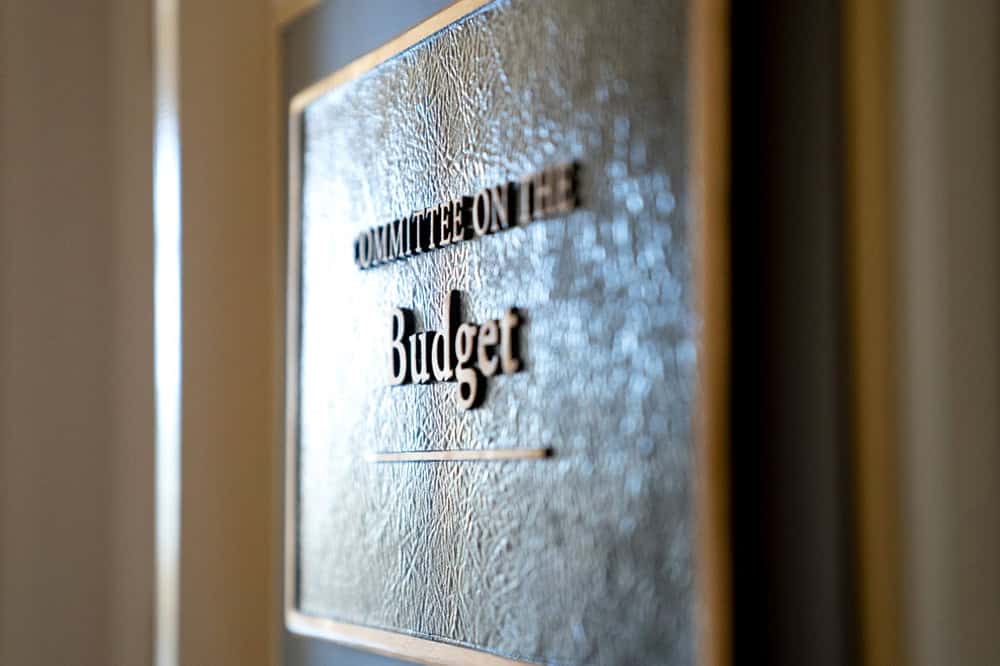As New Congress Gets to Work, Nation’s Long-Term Fiscal Outlook Remains Top Concern

NEW YORK — As we enter a new year, the Peter G. Peterson Foundation’s January Fiscal Confidence Index, a monthly measure of public attitudes about the nation’s long-term debt and the efforts elected leaders are making to address America’s fiscal challenges, is 52 (100 is neutral), indicating voters’ ongoing concern about America’s fiscal future. Even with the positive news that the economy is improving and short-term deficits are lower, Americans understand that the nation still has an unsustainable long-term fiscal outlook.
Following the swearing in of the 114th Congress, nearly 8 in ten voters (79%) say the President and Congress should spend more time addressing the nation’s debt, with the same number (79%) calling for national debt to be among our leaders’ top three priorities. Overall, voters are twice as likely to believe the country is on the wrong track on addressing our nation’s long-term debt.
“As yesterday’s CBO report shows, our nation’s long-term fiscal challenges remain,” said Michael A. Peterson, President and COO of the Peter G. Peterson Foundation. “Despite recent improvements, CBO projects that deficits will begin rising again in just 2 years. Soon thereafter, the fundamental drivers of debt, including our aging population and rising healthcare costs, will lead to much more rapid increases in our long-term debt. Voters understand getting our fiscal house in order is necessary to ensure a growing and prosperous economic future.”
In a report released yesterday, CBO warned that the debt path we’re on would “have serious negative consequences, including increasing federal spending for interest payments; restraining economic growth in the long term; giving policymakers less flexibility to respond to unexpected challenges; and eventually heightening the risk of a fiscal crisis.”
The Fiscal Confidence Index measures public opinion about the national debt by asking six questions in three key areas:
- CONCERN: Level of concern and views about the direction of the national debt.
- PRIORITY: How high a priority addressing the debt should be for elected leaders.
- EXPECTATIONS: Expectations about whether the debt situation will get better or worse in the next few years.
The survey results from these three areas are weighted equally and averaged to produce the Fiscal Confidence Index value. The Fiscal Confidence Index, like the Consumer Confidence Index, is indexed on a scale of 0 to 200, with a neutral midpoint of 100. A reading above 100 indicates positive sentiment. A reading below 100 indicates negative sentiment.
Fiscal Confidence Index Key Data Points:
- The January 2015 Fiscal Confidence Index value is 52. A score of 100 is neutral. Values below 100 show negative sentiment, while values above 100 show positive sentiment. (December’s value was 43. November’s value was 44.)
- The current Fiscal Confidence Index score for CONCERN about the debt is 40, indicating deep concern about the debt. The score for debt as a PRIORITY that leaders must address is 27, indicating that Americans want elected leaders to make addressing long-term debt a high priority. The score for EXPECTATIONS about progress on the debt is 78, indicating strong pessimism about the direction of long-term fiscal policy in the next few years. The Fiscal Confidence Index of 52 is the average of these three sub-category scores.
- For a description of the complete methodology, see the Appendix below.
The Peter G. Peterson Foundation commissioned a poll by the Global Strategy Group and North Star Opinion Research to survey public opinion on the national debt. The nationwide poll included 1,013 U.S. registered voters, surveyed by telephone between January 19 and January 22, 2015. The poll has a margin of error of +/- 3.1%. The poll examined voters’ opinions on the national debt, political leadership, and America’s fiscal and economic health.
Detailed poll results can be found online at: www.pgpf.org/what-we-are-doing/education-and-awareness/fiscal-confidence-index
About the Peter G. Peterson Foundation
The Peter G. Peterson Foundation is a nonprofit, nonpartisan organization that is dedicated to increasing public awareness of the nature and urgency of key long-term fiscal challenges threatening America’s future, and to accelerating action on them. To address these challenges successfully, we work to bring Americans together to find and implement sensible, long-term solutions that transcend age, party lines and ideological divides in order to achieve real results. To learn more, please visit www.pgpf.org.
APPENDIX: Fiscal Confidence Index Methodology and Questions
- The Fiscal Confidence Index is released monthly by the Peter G. Peterson Foundation.
- The Fiscal Confidence Index value is based on six questions in three categories.
- As is done with the Consumer Confidence Index, the first step in calculating the Fiscal Confidence Index is determining the “Relative Value” for each question. This calculation is made by taking the positive response for each question and dividing it by the sum of the positive and negative responses. Each question was asked on a four-point scale, and answers were weighted according to intensity, with the strongest responses counting twice as much as the middle responses (“much” better or worse answers count twice as heavily as “somewhat” better or worse answers).
- The scores for the Concern, Priority, and Expectations categories are determined by averaging the scores derived from the two questions in each category.
- The Fiscal Confidence Index value is converted from the Relative Value to place it on a scale on which 100 indicates equal positive and negative sentiment, while values below 100 indicate negative sentiment and values above 100 indicate positive sentiment.
- The Peter G. Peterson Foundation commissioned the poll by the Global Strategy Group and North Star Opinion Research to survey public opinion on the national debt. The nationwide poll included 1,013 U.S. registered voters, surveyed by telephone between January 19 and January 22, 2015. The poll has a margin of error of +/- 3.1%. The poll examined voters’ opinions on the national debt, political leadership, and America’s fiscal and economic health.
- The questions are as follows:
| CONCERN (40) | ||||
|---|---|---|---|---|
| Thinking about our national debt over the last few years, would you say your level of concern has increased or decreased? ◊ Is that a lot or just a little? |
Jan 2015 | Dec 2014 | Nov 2014 | |
| Increased a lot | 44% | 48% | 47% | |
| Increased a little | 17% | 19% | 19% | |
| Decreased a little | 13% | 10% | 10% | |
| Decreased a lot | 8% | 6% | 7% | |
| (No change) | 16% | 16% | 15% | |
| (Don’t Know/Refused) | 2% | NA | 1% | |
| INCREASED (NET) | 61% | 67% | 67% | |
| DECREASED (NET) | 20% | 16% | 17% | |
| When it comes to addressing our national debt, would you say things in the United States are heading in the right direction or do you think things are off on the wrong track? ◊ Do you feel that way strongly or just somewhat? |
Jan 2015 | Dec 2014 | Nov 2014 | |
| Right direction-Strongly | 11% | 7% | 8% | |
| Right direction-Somewhat | 18% | 16% | 15% | |
| Wrong track-Somewhat | 19% | 18% | 18% | |
| Wrong track-Strongly | 38% | 49% | 46% | |
| (Neither/Mixed) | 10% | 8% | 7% | |
| (Don’t Know/Refused) | 4% | 3% | 6% | |
| RIGHT DIRECTION (NET) | 28% | 23% | 24% | |
| WRONG TRACK (NET) | 57% | 67% | 63% | |
| PRIORITY (27) | ||||
|---|---|---|---|---|
| Some people say that addressing the national debt should be among the President and Congress’ top 3 priorities. Do you agree or disagree? ◊ Do you feel that way strongly or just somewhat? |
Jan 2015 | Dec 2014 | Nov 2014 | |
| Strongly agree | 55% | 60% | 56% | |
| Somewhat agree | 24% | 20% | 25% | |
| Somewhat disagree | 9% | 10% | 10% | |
| Strongly disagree | 8% | 7% | 6% | |
| (Don’t Know/Refused) | 5% | 3% | 4% | |
| AGREE (NET) | 79% | 80% | 81% | |
| DISAGREE (NET) | 17% | 17% | 16% | |
| And when it comes to our national debt, do you think it is an issue that the President and Congress should spend more time addressing or less time addressing? ◊ Would you say a lot (more or less) time or just a little? |
Jan 2015 | Dec 2014 | Nov 2014 | |
| A lot more time | 56% | 60% | 60% | |
| A little more time | 23% | 24% | 22% | |
| A little less time | 8% | 5% | 6% | |
| A lot less time | 5% | 4% | 4% | |
| (The same amount of time) | 5% | 4% | 4% | |
| (Don’t Know/Refused) | 4% | 3% | 4% | |
| MORE TIME (NET) | 79% | 84% | 82% | |
| LESS TIME (NET) | 13% | 9% | 11% | |
| EXPECTATIONS (78) | ||||
|---|---|---|---|---|
| And thinking about our national debt over the next few years, do you expect the problem to get better or worse? ◊ Is that much (better or worse) or just somewhat (better or worse)? |
Jan 2015 | Dec 2014 | Nov 2014 | |
| Much better | 7% | 7% | 7% | |
| Somewhat better | 22% | 19% | 18% | |
| Somewhat worse | 30% | 28% | 30% | |
| Much worse | 29% | 34% | 35% | |
| (No change) | 6% | 8% | 5% | |
| (Don’t know/Refused) | 6% | 5% | 5% | |
| BETTER (NET) | 29% | 25% | 25% | |
| WORSE (NET) | 59% | 62% | 65% | |
| And when it comes to our national debt, are you optimistic or pessimistic that the United States will be able to make progress on our national debt over the next few years? ◊ Would you say you are very (optimistic or pessimistic) or just somewhat? |
Jan 2015 | Dec 2014 | Nov 2014 | |
| Very optimistic | 18% | 18% | 16% | |
| Somewhat optimistic | 30% | 29% | 29% | |
| Somewhat pessimistic | 19% | 20% | 19% | |
| Very pessimistic | 26% | 28% | 29% | |
| (Neither/Mixed) | 5% | 4% | 4% | |
| (Don’t Know/Refused) | 2% | 2% | 3% | |
| OPTIMISTIC (NET) | 48% | 47% | 45% | |
| PESSIMISTIC (NET) | 44% | 48% | 48% | |
Further Reading
National Debt Puts Upward Pressure on Inflation and Interest Rates
America’s unsustainable fiscal outlook can have “significant consequences for price stability, interest rates, and overall economic performance,” according to a new report.
Here’s What a Budget Gimmick Is and How to Spot One
Lawmakers should avoid the use of budget gimmicks, which can hide the true fiscal impact of legislation.
What Is the Farm Bill, and Why Does It Matter for the Federal Budget?
The Farm Bill provides an opportunity for policymakers to comprehensively address agricultural, food, conservation, and other issues.


